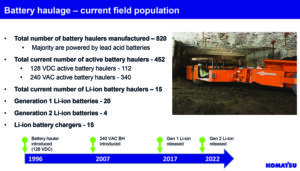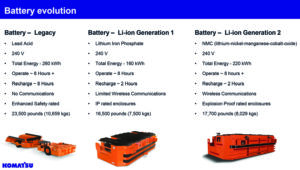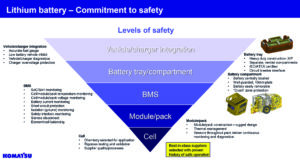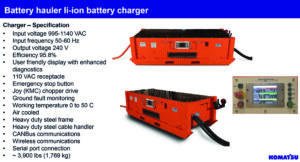
Lead-acid batteries have served the industry well and Li-ion batteries could improve productivity. (Graphic: Komatsu)
Lithium-ion batteries offer advantages over lead-acid batteries
Komatsu has been testing lithium-ion (Li-ion) batteries for use on its battery-powered hauler product line for several years. These machines were launched in the 1990s with lead acid batteries, and they have performed well with improvements over the years. Li-ion technology will be an evolutionary step change in technology for this product line.
During the development of Li-ion batteries for underground use, Komatsu also developed its own smart charging system. The Joy-built charging system is working so well, the company is planning to use it in underground hardrock mining and surface mining applications, and on the construction side as well.
In planning for the transition from the familiar lead-acid battery
to the unfamiliar Li-ion batteries for underground coal mining applications, Komatsu developed rigorous testing requirements. Initially it found itself in unchartered waters and today it is leading the effort to help shape policy for an area where little currently exists.
Comparing Lead-acid and Li-ion
Komatsu has manufactured more than 800 battery-powered haulers. Most of them are powered by lead-acid batteries. More than 450 machines are still operating in the field today. The company currently has 15 Li-ion powered battery haulers running in industrial mineral mining applications in the U.K. and Canada, explained Jerry Davis, principal engineer for Komatsu Mining. “These machines can be powered by either lead-acid or Li-ion batteries,” he said. “We have done that for a reason. A mine can purchase a new machine, powered by lead-acid, and then cycle in the new technology when it’s ready to adopt it.”
The development timeline for the battery-powered hauler began in 1996. “Our first major upgrade to the the hauler was in 2007,” Davis said. “That’s when we increased the battery voltage as well as updated the electrics. In 2017, we released our first-generation Li-ion battery, and then last year we released our second-generation Li-ion battery.”
Komatsu currently has 20 of its first-generation batteries and four second generation batteries operating in the field. The company has more orders on the books, so those numbers will only grow. It also has 15 chargers running in the field today.
The current lead acid batteries are a 240-volt system. They weigh 23,500 lb. They generate 260 kilowatt-hours (kWh) and they are designed to operate for at least eight hours. The recharge time is eight hours. Lead-acid batteries are Enhanced Safety Rated, but they have no communications compare to modern Li-ion batteries.
Komatsu’s first-generation battery was a lithium iron phosphate (LFP) battery. It’s also a 240-volt system. It weighs 16,500 lb. The total energy is 160 kWh. It’s designed to operate about eight hours. It recharges in two hours and it has limited wireless communications. The batteries are stored in IP-rated enclosures, meaning they are really intended for non-gaseous industrial mineral mines.
“The reason why the total energy is different has to do with battery utilization,” Davis said. “With lead-acid, the machine uses about 80% of the battery’s capacity. With Li-ion, it would use 90% to 95% of the battery’s capacity. When we were reviewing a lot of the usage figures from the field, we found that most applications only use about half the capacity of the battery. So, we thought 160 kWh would get us in the ballpark of a lead acid battery as far as performance.”
The transition to lithium reduces the weight substantially. “It is 7,000 lb lighter and that gives it a big advantage mechanically,” Davis said.
For its second-generation battery, Komatsu adopted a nickel-magnesium-cobalt (NMC) battery. It’s a 240-volt system that generates 220 kWh. It weighs 18,000 lb, charges in two hours, and has wireless communications. This system is intended for underground coal use and the batteries are stored in explosion-proof (XP) enclosures.
“The advantage of the NMC battery is volumetric energy density,” Davis said. “In that same 240-volt envelope, we were able to achieve 220 kWh for eight hours or more. That means more shift runtime. The XP enclosure requires more steel, which made the battery heavier.”

In addition to faster charging times, the reduced weight of Li-ion batteries make the XP enclosure practical. (Graphic: Komatsu)
Advantages of Li-ion
The big differences between lead acid, LFP and NMC batteries result from the chemistry. The useful life of a lead acid battery is about three to four years, Davis explained. “Some mines are getting about five years or more, depending on how they use and care for the batteries,” Davis said. “With lithium, we’re looking at a 7- to 10-year battery life. Our first-generation batteries, which have been in the field since 2017, are still running at about 90% state of health. We might even be able to go longer than seven to 10 years.”
Capacity fade is another consideration. Lead-acid batteries will typically show age at about six months, Davis explained, and capacity will start to taper off a little bit. “With Li-ion batteries, the capacity remains relatively flat throughout their life,” Davis said. “They are designed to run eight plus hours and they will.”
The recharge time is a big advantage for Li-ion batteries. The difference is stark: eight hours to two hours. “With Li-ion, no cool down period is needed,” Davis said. “When we sell a battery-powered hauler, we would also sell three lead-acid batteries per hauler. Now we’re able to sell one and a half. Some mines run one battery per hauler, others like to run two, so they have a spare battery at all times.”
Lack of maintenance is another advantage for Li-ion. After each shift water must be added to lead-acid batteries. “The miners must lift the covers and recharge it,” Davis said. “The Li-ion battery is completely sealed and it doesn’t release hydrogen when it’s recharging.”
Lead acid batteries do not require active cooling. “We put a lot of energy into a Li-ion battery to charge it in a short period of time,” Davis said. “With the first generation [LFP] batteries, we added a cooling system for charging purposes. We found we really didn’t need it. Now, we better understand the technology. When we introduced the NMC battery, we were able to eliminate the cooling system in this application. That’s another advantage for NMC.”
Lead-acid batteries do not have a diagnostic system. With Li-ion, the operators always know the state of that battery. The latest generation has wireless communications, which dumps data at the feederbreaker or the continuous miner. If a mine is using nodes, battery health is available in nearly real time.
Komatsu performed some interesting comparison tests on the surface. “We wanted to see how lead-acid and Li-ion performance compared on grade,” Davis said. “With lead acid, the power seems to be a little softer with big fluctuations in the bus voltage. Lithium remains relatively flat throughout the duty cycle. If a mine had bad bottom conditions, really muddy or bumpy, the machine would see constant voltage all the time. It would have better tractive force with a Li-ion battery. The same stands true for climbing slopes. Operators would not need to worry about the machine bogging down.”
Commitment to Zero Harm
Komatsu is committed to safely operating batteries. It has established five levels of safety for the batteries. “It starts at a cell level,” Davis said. “We looked for world class suppliers that have the proven track record of safe operations. They must have very good manufacturing processes in place. We also expect our suppliers to pass very rigorous testing at the cell level. We want to make sure that that battery cell is as safe as possible.”
The next level of safety is the module/pack level. “The modules must be very rugged,” Davis said. “They need to be mine duty. A rugged design is imperative.”
The Battery Management System (BMS) has to have very good thermal management. “We monitor temperatures as well as voltages at the cell level,” Davis said. With the BMS, we monitor the state of charge, the state of health and the safety interlocks. The batteries have short circuit protection. We have built as many protective features into the system as possible.”
The battery tray or compartment is another overlapping protective feature. “All of our batteries are housed in heavy duty steel enclosures, whether it’s an XP tray or just a battery box,” Davis said. “We want to protect against any type of roof or rib fall that could pierce the battery.”
The last level of protection involves the integration of the charger. “The machine will tell operators when the capacity is getting low,” Davis said. “We have an accurate ‘fuel gauge’ right on the display in front of the operator. They always know the ‘fuel level.’ If they’re running when the battery gets low, it sends a warning message. If they continue to run, it will send another fault message and start disabling some of the features of the battery hauler, like the bed. That encourages an operator to go get the battery charged.”
The charger acts as a secondary means of protection. “We have high voltage limits set for it,” Davis said. “If the battery is on the charger and, for whatever reason, the BMS quits working, the charger will stop charging that battery at that level. It will not allow for an over voltage situation.
“We are also working on Joy Connect,” Davis said. “With the battery, we have wireless Communications. It can talk to the charger. The charger can then send that data through the mine network to a surface PC then to the cloud. One of our smart service centers can monitor the battery. Engineering can monitor everything as well. They can easily see the status and the health of the battery.”
For example, if a cell temperature reaches a warning level, Komatsu will send a message to notify the mine digitally in real time. If the battery temperature continues to increase, Komatsu will send another fault message, saying it’s time to take that battery out of service and address the issue. “At the same time, it will disable the pack that that cell is in,” Davis said. “That pack is de-energized. The mine has other packs that will allow it to move the battery hauler to a safe area so they can address the issue.”

As part of its commitment to safely operating Li-ion batteries, Komatsu has established five levels of safety protection. (Graphic: Komatsu)
Testing and Training Requirements
When Komatsu started its Li-ion project, the existing mining standards did not really address testing requirements. “We started with UN 38.3,” Davis said. “You really need this standard for shipping lithium batteries. There is a UL and IEC standard that’s similar to UN 38.3. We tested to those three standards and we thought that was a good representation of what we needed to get these batteries approved.”
These tests included a crush test, a short circuit test, and a thermal test. “We have also performed explosive atmosphere testing and we really were required to do that to gain IEC certification,” Davis said.
As far as other abuse testing, Komatsu tried to simulate mine conditions and possible mine failures. “We wanted to test to those abuse conditions,” Davis said. “We also conducted thermal propagation tests. If the battery would fail for some reason, we want to understand what happens to that battery and the consequences. During thermal runaway testing, we found that the battery will emit smoke into the atmosphere, however, there will be no flame present outside of the battery.”
There are several challenges to introducing Li-ion batteries underground. Mining conditions underground are very difficult. Equipment operates in confined surroundings with a potentially explosive atmosphere. If a roof or rib fall occurs, will the battery survive? Coal dust and methane are present. How will the battery handle those type of conditions?
“The federal standards and regulations in the U.S. haven’t caught up to the technology and we are a leading the way in this area,” Davis said. “If you look at U.S. Code of Federal Regulations Title 30, everything pertains to lead acid batteries. There is really nothing that tells you what you need to do to get certification for Li-ion batteries. There is the 7.52 clause for new technology. It’s not real descriptive as far as certification requirements. We’re working through those standards now. Some groups in Canada have released standards for batteries operating in underground hardrock applications.”
As far as battery maintenance, Komatsu prefers to address any battery issues. “We let the mine do basic maintenance,” Davis said “However, we prefer to do anything that needs to be performed inside of the battery. Another consideration is spare parts, like a Li-ion module, and whether they are stocked on site. EHS needs to be involved to store Li-ion batteries on site. It’s not real easy to ship Li-ion batteries via air freight.”
Mines in some regions consider working with batteries as hot work. “If testing or troubleshooting is required, the battery can’t be fully de-energized,” Davis said. “That’s considered hot work. We’re working with mines in those regions to address those strategies.”
A thorough training program to educate miners on this new technology is vital especially when it comes to incident mitigation. “We want to plan for the worst-case scenario and we want to make sure we know what to do if that worst case scenario should happen,” Davis said. “Everyone has seen the videos of BEVs bursting into flames. We do a lot of testing to understand what happens with that battery should a thermal runaway event occur. Komatsu is very aware the challenges facing underground mining when it comes to introducing Li-ion batteries and is working diligently to provide solutions to help the industry drive toward zero harm.”
The Joy-built Charger
The Joy designed-and-built charger has been a success story for Komatsu. “When we started our Li-ion development project, we were unable find a good industrial charger for the underground mining environment,” Davis said. “So, we made the decision to develop our own charger. We were able to repurpose a lot of parts that you would see on a Joy continuous miner or a longwall shearer.

Unable to find a solution that met its needs, Komatsu developed its own charging system, the Joy designed and built charger. (Graphic: Komatsu)
One of the major components in the charger, for example, is the Joy OptiDrive. “It’s configured differently, as a chopper drive, but it is basically the same package that’s found on the Joy continuous miner,” Davis said. “For this application, the input voltage is 995 to 1,140. We can design it for whatever voltage is required. Canada, for example, requires 600 volts.”
The output voltage needs to match the battery, which is 240 volts for this application. “The charger is very efficient, about 96%,” Davis said. “It has a user-friendly display. The construction is heavy duty and intended for use in the mining environment. It’s been very successful for us and it’s actually offered us the opportunity to expand into other areas.”
Davis and his team are looking at applications with Komatsu’s underground hard rock divisions, supplying chargers for jumbo drills and LHDs. “We are also developing onboard chargers,” Davis said. “We are working with our surface group for haul truck applications and possibly branching out to construction equipment as well.”
The charger is equipped with CANBUS and wireless communications so it can talk to the battery. “It’s a very smart charger,” Davis said. “About three years ago, a strategic initiative was released within Komatsu to develop a Battery Center of Excellence Group. The goal was to increase collaboration and synergy in battery development. We began to work together with the other Komatsu divisions.”
Safety is the top priority, Davis explained. “We have demonstrated that with various levels of protective checks within every battery system,” Davis said. “We use the cells and chemistry that we think will work best for the mining environment.”
Komatsu is currently evaluating a battery option for its tethered vehicles (shuttle cars). The jumbo drill should be available later next year and the LHD should follow. Davis and his team are developing a new generation charger that they plan on having available early next year.
This article is based on a presentation that Davis gave at the U.S. Coal Show in Pittsburgh during June 2023.


